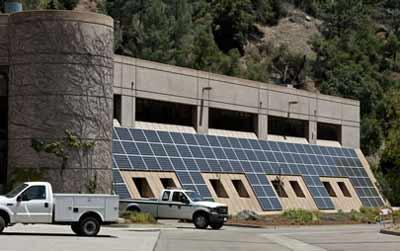A new solar energy project at Yosemite National Park will help cut utility costs, and the system can claim at least two titles for such systems in the National Park System.
The El Portal photovoltaic project consists of 2,800 solar panels and produces approximately 800,000 kilowatt hours per year. That makes it the largest NPS-managed photovoltaic project within the Pacific West Region and the largest grid-connected photovoltaic system owned and operated by the NPS. Such systems allow use of electricity from both the commercial grid and the solar panels as conditions dictate; excess power generated by the solar components can be "sold" to the cooperating utility company.
The park estimates savings of approximately $50,000 per year on electricity purchased off the grid and is expecting to receive a $700,000 energy rebate from Pacific Gas & Electric Co. (PG&E) over the next five years. This represents a reduction in electricity purchased off the grid about 12 percent.
Superintendent Don Neubacher led a ribbon cutting ceremony on July 27 to dedicate the project. “The collaborative effort to design and build this system has come to fruition and we are extremely proud of the results,” said Neubacher. “We are committed to being a leader in renewable energy and this project exemplifies our efforts.”
Construction of the system was completed in February and the interconnection agreement with PG&E was signed in late June.
The location in El Portal was chosen for the photovoltaic project due to the high amount of direct sunlight the site receives. The El Portal Maintenance and Administrative Complex is located at the western edge of Yosemite National Park adjacent to Highway 140. The area includes park offices, a vehicle maintenance facility, the park warehouse, and other park operations.




Comments
"Savings" may be fleeting. A local gov't entity in East Tenn. claimed a given "Savings," but did mention the cost (paid for by federal tax payers). This calculated to pay back over 32 years assuming accuracy of "savings" and no upkeep/maintenence costs in the ensuing years. Nope, it's still not ready for prime time.
This project is a great illustration of the potential of such systems but I would not portray it as "saving" dollars. Subtracting the payback from the power company, taxpayers are left with $5.1 million in cost and an annual saving of $50,0000 off the grid. That means a cost recovery in 100 years based on solar panels that probably have, at best, a 25 year life span. This is not the kind of arithmetic that builds confidence in the 2009 Stimulus Bill unless you own and/or install green energy power projects.